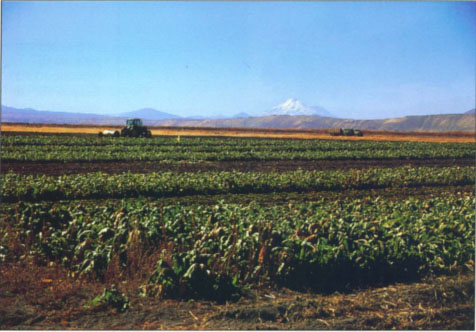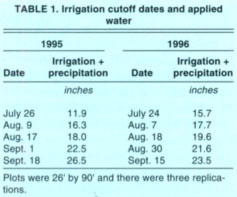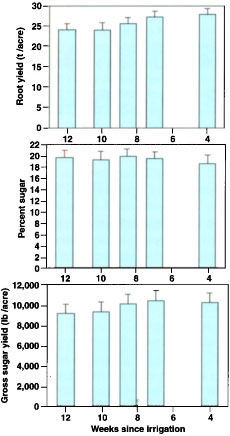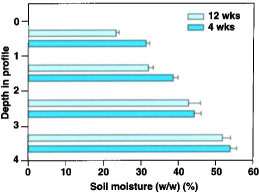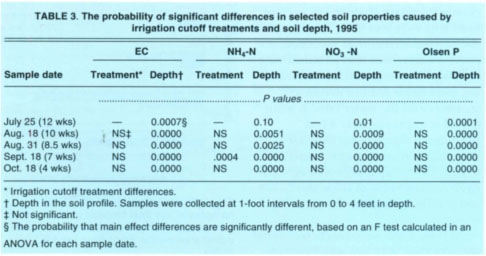All Issues
Earlier irrigation cutoff for sugarbeets conserves water
Publication Information
California Agriculture 52(1):21-24. https://doi.org/10.3733/ca.v052n01p21
Published January 01, 1998
PDF | Citation | Permissions
Abstract
In the Tulelake region near the Oregon border, sugarbeets are grown on organic soil reclaimed from a shallow lake. Groundwater is present continuously through-out the season at depths of approximately 4 feet in most fields. Typically, beets planted in April and May are irrigated until mid-September and harvested in October. However, environmental restrictions may reduce farm water supplies in the future. To determine whether sugarbeets can be grown with less irrigation water, five irrigation cutoff treatments were applied to replicated large plots at approximately 2-week intervals starting in mid-july in 1995 and 1996. Results from these trials suggest that farmers can save 4 to 6 inches of irrigation water by cutting off irrigation to sugarbeet crops 6 to 7 weeks before harvest under these soil and climate conditions.
Full text
In trials conducted in the Tulelake region, sugarbeets compensated by recovering some shallow groundwater when irrigation was cut off early.
Sugarbeets have been grown for only a few years in the Upper Klamath Basin of California and Oregon. Despite a short growing season of 150 to 160 days, yields of 20 to 30 tons of roots and 8,000 to 11,000 pounds of sugar per acre are achieved. This makes the basin one of the most productive short-season locations for sugarbeets in the world.
Starting in the fall, the roots are stored in large piles for as long as 3 months and shipped as needed to Woodland for processing. Because of freezing temperatures in the fall, the Upper Basin is the only location producing beets for California factories where beets can be stored for an extended period. These roots fill an important niche in factory operations, thereby helping to maintain the beet crop as a rotation option for farmer in other location in the state.
By cutting off irrigations to sugarbeet crops 6 to 7 weeks before harvest, researchers were able to save water without losing sugar or yield.
Growers in the Tulelake and Klamath Irrigation Districts may be faced with reductions in water supplies for irrigation in the near future. Mandated minimum flow rates in the Klamath River could reduce water supplies available for crop production, especially in dry years, as well as in late summer and fall in late summer and fall in many normal years. If irrigation of sugarbeets during late summer can be reduced or curtailed without loss of economic yield, less water may need to be diverted for irrigation and farm incomes will be protected. This would meet both environmental and farm economic yields, less water may need to be diverted for irrigation and farm incomes will be protected. This would meet both environmental and economic objectives.
All crops need adequate amounts of water for economic yields. There is a linear relationship between yield and crop evapotranspiration (ETc) (Ghariani 1981). Despite the adverse effects of prolonged moisture stress, irrigation is commonly withheld from beet crops toward the end of the crop production period. Because sugarbeets are among the deepest rooted of the annual crops, they are able to recover water deep in the soil profile. Also, modest losses in root yield following irrigation cutoff are typically compensated by small increases in sugar (sucrose) percentage, resulting in similar gross sugar yields.
To improve the practice of with-holding late-season irrigations, cutoff experiments have been performed in Imperial, Kern, Fresno, Yolo and Glenn counties. In the hot interior valley regions of California, irrigation may be stopped without economic loss 3 to 4 weeks prior to harvest, depending on location, season and the soil's available water content. Similar results have also been reported from the Pacific Northwest and the Plains states where irrigation is used. In one experiment in the Delta region of California on organic soils, established sugarbeets were able to grow throughout the summer without irrigation by recovering water from a shallow subsurface water table at a depth of 3 to 4 feet. However, root and sugar yields were lower for unirrigated treatments than for treatments with supplemental irrigation (Henderson et al. 1968). In a second experiment carried out above a shallow water table in the Delta, sugar yields were unaffected or tended to be marginally greater when irrigation was cut off in mid-August, compared to mid-September, for an October-harvested crop (Hills et al. 1990).
Current practice in the Tulelake region is to cease irrigating about 4 weeks prior to harvest, but there is no experimental basis for this practice. Because a shallow water table is present in most locations in the region, sugarbeets should be able to recover soil moisture from deeper in the profile and compensate for a modest loss of root yield through an increase in sucrose percent. It may be possible to cut off irrigation of sugarbeets earlier than 2 to 4 weeks prior to harvest, saving one or more irrigations.
Our objectives were to evaluate the effects of different irrigation cutoff periods on root and sugar yield; to monitor changes in root yield and sucrose accumulation; and to evaluate changes in gravimetric soil moisture and other soil properties that may influence water quality in the region as a function of sample date and depth in the soil profile.
Five irrigation cutoffs
We established plots at the lease lands site of the Intermountain Research and Extension Center (IREC) in Tulelake. The IREC site is located on soils with physical and hydrologic characteristics common to most of the farms in the Tulelake Irrigation District — Mixed, mesic Andequeptic Haploquolls. These soils are lucustrine sediments derived from volcanic ash and diatomite. They are high in organic matter (10% to 15%). Plots were 26 feet by 90 feet, were separated from each other by 26-foot-wide buffer plots and reasonably simulated farm conditions.
We replicated five irrigation cutoff treatments three times using a randomized complete block design. The cutoff dates and the amount of water applied as irrigation or occurring as rainfall during the growing season in both years are reported in table 1. All plots were irrigated uniformly until the first irrigation cutoff treatment was initiated. Best irrigation practices are not adequately defined for sugarbeets in the Tulelake regions because the crop was recently introduced. Cutoff treatments were chosen to provide a wide range of comparisons.
Root and soil samples
Roots were sampled from each treatment when cutoffs were imposed, and subsequently at each successive cutoff date and again at final harvest. They were weighed and analyzed for sucrose and impurities such as sodium (Na), potassium (K) and nitrogen (amino-N) compounds. Soil samples were collected from the surface to 4 feet deep in 1-feet intervals, weighed and oven dried. We analyzed gravimetric moisture content, salinity as electrical conductivity of a saturated paste extract (ECe), nitrogen (N) and phosphorus (P) content from samples collected at 1-foot increments to 4 feet in depth at each cutoff date. Final harvests and soil samples were collected in mid-October.
Fig. 1. Root yields (fresh weight), percent sugar and gross sugar yields for 1995 and 1996 growing seasons combined. Error bars are LSD (0.05) (SAS Institute, Cary, N. Carolina).
Root and sugar yields
Root and sugar yields were not significantly different between years (table 2), allowing for combined analysis of both years' data. In both years,root yields increased from 23 to 28 tons per acre as the cutoff period decreased, but sucrose percent declined from greater than 19% to 18.5% with late-season irrigation (4 weeks before harvest), resulting in near-equivalent gross sugar yields over the last three cutoff dates (fig. 1).
Soil moisture and nutrients
In both years, beets in cutoff treatments reduced the soil water content in the surface 2 feet compared to fully irrigated treatments, but there were no significant differences in soil moisture content deeper in the profile (fig. 2). Soil nutrients were not affected by the timing of irrigation cutoff, but changed through the season (table 3). Date for soil nitrate nitrogen (NO3-N) indicate a significant decline throughout the profile as the season progressed. There were no obvious trends for soil ammonium nitrogen (NH4) and P (fig. 3). Salinity (ECe) increased with increasing depth in the profile, and was significantly lower in the fully irrigated treatment (fig. 4).
Earlier cut off in Tulelake?
The Tulelake region is unusual in many ways. Much of the land is reclaimed from shallow lakes, which left soils high in organic matter (approximately 6% total carbon in the surface foot) with excellent tilth. These organic soils are underlain with saturated, impervious clays that restrict subsurface drainage. Drainage ditches surrounding most fields remove excess soil moisture and the water table is maintained at approximately 4 feet throughout the growing season by pumps that remove water from the drains. Crops capable of rooting 4 feet deep can use some of the water in the soil profile throughout the growing season.
Fig. 2. Soil moisture by depth in the profile at the final harvest (mid-October) in 1995 and 1996. There were significant differences at the 0-to 1-foot and 1-foot to 2-foot depths, but not deeper in the profile. Error bars are standard deviations of the means. Soils in the Tulebasin series hold 0.3 to 0.5 inches of available water per inch (4 to 6 inches per foot), depending on depth in the profile and organic matter content.
Fig. 3. Average nutrient contents in the 0 to 4 foot profile at harvest in 1995. NO3-N declined from greater than 20 mg/kg to less than 10 mg/kg during the July to October period.
Fig. 4. Electrical conductivity of soil samples at the final harvest (mid-October) from the 12 week, 8- to 9-week and 4-week cutoff treatments. Error bars are for LSD (0.05)
Water savings from early cutoff depend on location of the field, the growing season and the soil's available water content.
In these trials, sugarbeets recovered some of their seasonal water requirement from the shallow groundwater. Despite the presence of water through-out the growing season at 3 to 4 feet in depth, moisture stress in the upper part of the profile — were the majority of roots occur — reduced root and sugar yields in the longest cutoff treatments. However, at 7 to 8 weeks before harvest (late August) adverse effects from irrigation cutoff on gross and recoverable sugar yields were not observed. Near-equivalent amounts of sugar were produced with less irrigations, increasing the efficiency of sugarbeet irrigation. Carefully managed deficit irrigation seems in this way to be a beneficial practice in the production of sugarbeets in this region. These results agree well with earlier work on sugarbeets carried out in the Delta region on organic soils with shallow water tables (Henderson et al. 1968; Hills et al. 1990).
If irrigation water deliveries are reduced in the Upper Klamath Basin to comply with environmental regulations, especially late in the growing season, farmers growing sugarbeets should be able to produces economic crops, provided that subsurface soil moisture is present. Late-season irrigations requirements for potato and onion crops result in water being present in the region's delivery canals and drains, possibly contributing to the maintenance of shallow water tables throughout the district. If irrigation deliveries were curtailed for these crops as well, shallow water tables might fall, and sugarbeet crops might suffer more severe yield loss as well.
TABLE 3. The probability of significant differences in selected soil properties caused by irrigation cutoff treatments and soil depth, 1995
No trails were conducted on the region's mineral soils, which have deeper unsaturated zones and hold less available water than the organic soils in the region. The results reported here are not applicable to those soil conditions. It is more likely that the experience of farmers elsewhere in California will pertain to the mineral soils, suggesting not more than a 3- to 5-week cutoff period.
Conclusions
In our study testing five irrigation cutoff treatments in the Tulelake regions, sugarbeet yields were reduced when the length of the cutoff period was increased from 4 to 5 weeks to 12 weeks. Sucrose concentration was variable but tended to be higher in beets grown with longer cutoff durations. Gross sugar yields were equivalent when irrigation was cut off at any time over the last 4 to 9 weeks of the growing season in both years.
Farmers can save 4 to 6 inches of irrigation water by cutting off irrigation to sugarbeet crops 6 to 7 weeks before harvest under these soil and climate conditions. This may allow them to produce an economic beet crop even if irrigation supplies are curtailed late in the season, provided subsurface moisture is available.



